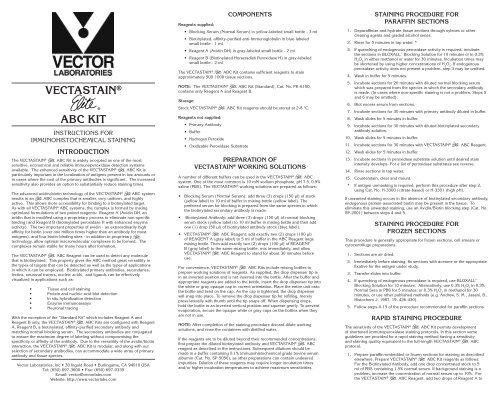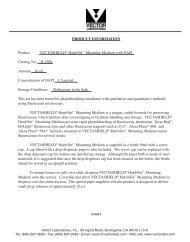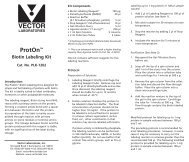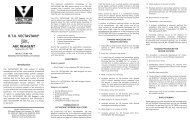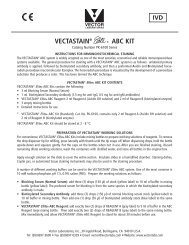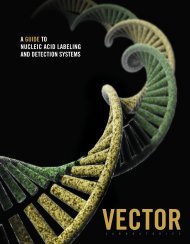Protocol - Vector Laboratories
Protocol - Vector Laboratories
Protocol - Vector Laboratories
You also want an ePaper? Increase the reach of your titles
YUMPU automatically turns print PDFs into web optimized ePapers that Google loves.
VECTASTAIN ®<br />
®<br />
ABC KIT<br />
INSTRUCTIONS FOR<br />
IMMUNOHISTOCHEMICAL STAINING<br />
INTRODUCTION<br />
The VECTASTAIN ® ABC Kit is widely accepted as one of the most<br />
sensitive, economical and reliable immunoperoxidase detection systems<br />
available. The enhanced sensitivity of the VECTASTAIN ® ABC Kit is<br />
particularly important in the localization of antigens present in low amounts or<br />
in cases where the cost of the primary antibodies is significant. The increased<br />
sensitivity also provides an option to substantially reduce staining times.<br />
The advanced avidin/biotin technology of the VECTASTAIN ® ABC system<br />
results in an ABC complex that is smaller, very uniform, and highly<br />
active. This allows more accessibility for binding to a biotinylated target.<br />
As with all VECTASTAIN ® ABC systems, the complex is formed by mixing<br />
optimized formulations of two paired reagents: Reagent A (Avidin DH, an<br />
avidin that is modified using a proprietary process to eliminate non-specific<br />
binding) and Reagent B (biotinylated peroxidase H with enhanced enzyme<br />
activity). The two important properties of avidin - an extraordinarily high<br />
affinity for biotin (over one million times higher than an antibody for most<br />
antigens), and four biotin-binding sites - in addition to proprietary<br />
technology, allow optimal macromolecular complexes to be formed. The<br />
complexes remain stable for many hours after formation.<br />
The VECTASTAIN ® ABC Reagent can be used to detect any molecule<br />
that is biotinylated. This property gives the ABC method great versatility in<br />
the types of targets that can be detected as well as the types of applications<br />
in which it can be employed. Biotinylated primary antibodies, secondaries,<br />
lectins, neuronal tracers, nucleic acids, and ligands can be effectively<br />
visualized in applications such as:<br />
• Tissue and cell staining<br />
• Protein and nucleic acid blot detection<br />
• In situ hybridization detection<br />
• Enzyme immunoassays<br />
• Neuronal tracing<br />
With the exception of the “Standard Kit” which includes Reagent A and<br />
Reagent B only, the VECTASTAIN ® ABC Kits are configured with Reagent<br />
A, Reagent B, a biotinylated, affinity-purified secondary antibody and<br />
matching normal blocking serum. The secondary antibodies are conjugated<br />
to ensure the maximum degree of labeling without compromising the<br />
specificity or affinity of the antibody. Due to the versatility of the avidin/biotin<br />
interaction, the VECTASTAIN ® ABC Kit is modular, and along with our<br />
selection of secondary antibodies, can accommodate a wide array of primary<br />
antibody and tissue species.<br />
<strong>Vector</strong> <strong>Laboratories</strong>, Inc.• 30 Ingold Road • Burlingame, CA 94010 USA<br />
Tel: (650) 697-3600 • Fax: (650) 697-0339<br />
Email: vector@vectorlabs.com<br />
Website: http://www.vectorlabs.com<br />
Reagents supplied:<br />
COMPONENTS<br />
• Blocking Serum (Normal Serum) in yellow-labeled small bottle - 3 ml<br />
• Biotinylated, affinity-purified anti-Immunoglobulin in blue-labeled<br />
small bottle - 1 ml<br />
• Reagent A (Avidin DH) in gray-labeled small bottle - 2 ml<br />
• Reagent B (Biotinylated Horseradish Peroxidase H) in gray-labeled<br />
small bottle - 2 ml<br />
The VECTASTAIN ® ABC Kit contains sufficient reagents to stain<br />
approximately 500-1000 tissue sections.<br />
NOTE: The VECTASTAIN ® ABC Kit (Standard), Cat. No. PK-6100,<br />
contains only Reagent A and Reagent B.<br />
Storage:<br />
Stock VECTASTAIN ®<br />
Reagents not supplied:<br />
• Primary Antibody<br />
• Buffer<br />
• Hydrogen Peroxide<br />
• Oxidizable Peroxidase Substrate<br />
ABC Kit reagents should be stored at 2-8 °C.<br />
PREPARATION OF<br />
VECTASTAIN ® WORKING SOLUTIONS<br />
A number of different buffers can be used in the VECTASTAIN ® ABC<br />
system. One of the most common is 10 mM sodium phosphate, pH 7.5, 0.9%<br />
saIine (PBS). The VECTASTAIN ® working solutions are prepared as follows:<br />
• Blocking Serum (Normal Serum): add three (3) drops (150 µl) of stock<br />
(yellow label) to 10 ml of buffer in mixing bottle (yellow label). The<br />
preferred serum for blocking is prepared from the same species in which<br />
the biotinylated secondary antibody is made.<br />
• Biotinylated Antibody: add three (3) drops (150 µl) of normal blocking<br />
serum stock (yellow label) to 10 ml buffer in mixing bottle and then add<br />
one (1) drop (50 µl) of biotinylated antibody stock (blue label).<br />
• VECTASTAIN ® ABC Reagent: add exactly two (2) drops (100 µl)<br />
of REAGENT A (gray label) to 5 ml of buffer in the ABC Reagent large<br />
mixing bottle. Then add exactly two (2) drops (100 µl) of REAGENT<br />
B (gray label) to the same mixing bottle, mix immediately, and allow<br />
VECTASTAIN ® ABC Reagent to stand for about 30 minutes before<br />
use.<br />
For convenience, VECTASTAIN ® ABC Kits include mixing bottles to<br />
prepare working solutions of reagents. As supplied, the drop dispenser tip is<br />
in an inverted position and is not inserted into the bottle. After the buffer and<br />
appropriate reagents are added to the bottle, insert the drop dispenser tip into<br />
the white or gray opaque cap in correct orientation. Place the entire unit onto<br />
the bottle and twist on the cap. As the cap is tightened, the drop dispenser<br />
will snap into place. To remove the drop dispenser tip for refilling, merely<br />
press laterally with thumb until the tip snaps off. When dispensing drops,<br />
hold the bottle in an inverted vertical position and squeeze gently. To prevent<br />
evaporation, secure the opaque white or gray caps on the bottles when they<br />
are not in use.<br />
NOTE: After completion of the staining procedure discard dilute working<br />
solutions, and rinse the containers with distilled water.<br />
If the reagents are to be diluted beyond their recommended concentrations,<br />
first prepare the diluted biotinylated antibody and VECTASTAIN ® ABC<br />
reagent as described in the instructions. Subsequent dilutions should be<br />
made in a buffer containing 0.1% immunohistochemical grade bovine serum<br />
albumin (Cat. No. SP-5050), as other preparations can contain undesired<br />
impurities. Dilution of these reagents may require longer incubation times<br />
and/or higher incubation temperatures to achieve maximum sensitivities.<br />
STAINING PROCEDURE FOR<br />
PARAFFIN SECTIONS<br />
1. Deparaffinize and hydrate tissue sections through xylenes or other<br />
clearing agents and graded alcohol series.<br />
2. Rinse for 5 minutes in tap water. *<br />
3. If quenching of endogenous peroxidase activity is required, incubate<br />
the sections in BLOXALL Blocking Solution for 10 minutes or in 0.3%<br />
H 2<br />
O 2<br />
in either methanol or water for 30 minutes. Incubation times may<br />
be shortened by using higher concentrations of H 2<br />
O 2<br />
. If endogenous<br />
peroxidase activity does not present a problem, step 3 may be omitted.<br />
4. Wash in buffer for 5 minutes.<br />
5. Incubate sections for 20 minutes with diluted normal blocking serum<br />
which was prepared from the species in which the secondary antibody<br />
is made. (In cases where non-specific staining is not a problem, Steps 5<br />
and 6 may be omitted).<br />
6. Blot excess serum from sections.<br />
7. Incubate sections for 30 minutes with primary antibody diluted in buffer.<br />
8. Wash slides for 5 minutes in buffer.<br />
9. Incubate sections for 30 minutes with diluted biotinylated secondary<br />
antibody solution.<br />
10. Wash slides for 5 minutes in buffer.<br />
11. Incubate sections for 30 minutes with VECTASTAIN ® ABC Reagent.<br />
12. Wash slides for 5 minutes in buffer.<br />
13. Incubate sections in peroxidase substrate solution until desired stain<br />
intensity develops. For a list of peroxidase substrates see reverse.<br />
14. Rinse sections in tap water.<br />
15. Counterstain, clear and mount.<br />
* If antigen unmasking is required, perform this procedure after step 2,<br />
using Cat. No. H-3300 (citrate-based) or H-3301 (high pH).<br />
If unwanted staining occurs in the absence of biotinylated secondary antibody,<br />
endogenous protein-associated biotin may be present in the tissue. To<br />
eliminate this unwanted staining, use an Avidin/Biotin blocking step (Cat. No.<br />
SP-2001) between steps 4 and 5.<br />
STAINING PROCEDURE FOR<br />
FROZEN SECTIONS<br />
This procedure is generally appropriate for frozen sections, cell smears or<br />
cytocentrifuge preparations.<br />
1. Sections are air dried.<br />
2. Immediately before staining, fix sections with acetone or the appropriate<br />
fixative for the antigen under study.<br />
3. Transfer slides into buffer.<br />
4. If quenching of endogenous peroxidase is required, use BLOXALL <br />
Blocking Solution for 10 minutes. Alternatively, use 0.3% H 2<br />
O 2<br />
in 0.3%<br />
Normal Sera in PBS for 5 minutes; or 0.3% H 2<br />
O 2<br />
in methanol for 30<br />
minutes, or use other published methods (e.g. Andrew, S. M., Jasani, B.,<br />
Histochem J. 1987, 19, 426-430).<br />
5. Follow steps 4-15 of the procedure recommended for paraffin sections.<br />
RAPID STAINING PROCEDURE<br />
The sensitivity of the VECTASTAIN ® ABC Kit permits development<br />
of shortened immunoperoxidase staining protocols. In this section some<br />
guidelines are provided for a rapid staining method having a sensitivity<br />
and staining quality equivalent to the full-length VECTASTAIN ® ABC<br />
protocol.<br />
1. Prepare paraffin-embedded or frozen sections for staining as described<br />
elsewhere. Prepare VECTASTAIN ® ABC Kit reagents as follows:<br />
For the Biotinylated Antibody, add one drop concentrated stock to 5<br />
ml of PBS containing 1.5% normal serum. If background staining is a<br />
problem, increase the concentration of normal serum up to 10%. For<br />
the VECTASTAIN ® ABC Reagent, add two drops of Reagent A to
2.5 ml buffer, mix, then add two drops of Reagent B. Mix and allow to<br />
stand for 5-30 minutes before use.<br />
2. If quenching of endogenous peroxidase is required, an accelerated<br />
quenching procedure can be employed. Treat sections with 3% hydrogen<br />
peroxide in water for 3-5 minutes. Alternatively, incubate in BLOXALL <br />
Blocking Solution for 10 minutes.<br />
3. Wash gently with a stream of buffer from a wash bottle.<br />
4. If background staining is a problem, incubate sections for 5-10 minutes<br />
in 2%-10% normal serum in buffer.<br />
5. Incubate sections with primary antibody.**<br />
6. Wash as in step 3.<br />
7. Incubate sections for 10 minutes with diluted biotinylated secondary<br />
antibody.<br />
8. Wash as in step 3.<br />
9. Incubate sections for 5 minutes with VECTASTAIN ® ABC Reagent.<br />
10. Wash as in step 3.<br />
11. Incubate sections in peroxidase substrate solution until desired stain<br />
intensity develops.<br />
12. Wash as in step 3.<br />
13. Counterstain, clear and mount.<br />
**The concentration, staining time and temperature of the primary antibody<br />
should be tailored to an investigator’s particular requirements. The increased<br />
sensitivity of the VECTASTAIN ® ABC Kit allows shorter primary<br />
antibody incubation times. For example, at primary antibody concentrations<br />
optimal for the regular VECTASTAIN ® ABC Kit, incubation times can be<br />
reduced at least in half when using the VECTASTAIN ® ABC Kit. Higher<br />
concentrations of primary antibody allow even shorter incubation times.<br />
NOTE: A very rapid procedure that provides excellent staining results can<br />
also be performed. Prepare diluted biotinylated secondary antibody 1 drop/<br />
2.5 ml. Prepare VECTASTAIN ® ABC Reagent as in the above protocol.<br />
Apply diluted VECTASTAIN ® ABC Kit reagents preheated to 37 °C.<br />
Incubate sections in each reagent for 2 minutes.<br />
A VECTASTAIN ® Universal Quick Kit (Cat. No. PK-8800), based on a<br />
preformed streptavidin/peroxidase complex, is also available to perform rapid<br />
immunohistochemical staining.<br />
NOTES:<br />
1. VECTASTAIN ® ABC Kits can be used in multiple antigen labeling<br />
applications. A brochure with protocols is available - “Discovery<br />
Through Color”. Please request a free printed copy or download it from<br />
our website: www.vectorlabs.com. Additional information on Enzyme<br />
Substrate Combinations, Counterstain/Substrate Compatibility, and<br />
Relative Substrate Sensitivity is also available on our website.<br />
2. Solutions containing sodium azide or other inhibitors of peroxidase<br />
activity should not be used in diluting the peroxidase substrate or the<br />
VECTASTAIN ® ABC Reagent. Do not add normal serum, non-fat<br />
dried milk, culture media or other potential sources of biotin to the ABC<br />
reagent. This may result in reduced sensitivity.<br />
3. The section should be well prepared. Fixation (generally, in buffered<br />
formalin not exceeding 4 percent formaldehyde) should be sufficient to<br />
maintain the integrity of the section throughout the staining procedure<br />
but not so harsh as to destroy the antigen under study. In some cases,<br />
use of Antigen Unmasking Solution (Cat. No. H-3300 or H-3301) and<br />
exposure to high temperatures can overcome loss of antigens due to<br />
fixation. During the staining procedure, do not allow the section to dry<br />
out. Use a humidified chamber for incubations.<br />
4. To avoid adsorption of the antibody to the plastic or glass container in<br />
which the final dilution is made, the primary antibody may be diluted<br />
in buffers containing 0.1% immunohistochemical grade bovine serum<br />
albumin or dilute Blocking Serum.<br />
5. Use only freshly prepared buffers. Bacterial contamination which can<br />
occur in buffers stored at room temperature may affect the quality of the<br />
staining. It is recommended that the VECTASTAIN ® ABC Reagent<br />
and substrate solution be prepared with glass distilled water. Deionized<br />
water (even with low conductivities) may contain inhibitors of peroxidase<br />
and can reduce sensitivity.<br />
6. The A and B reagents in the kits are matched. Do not use an A reagent<br />
from one kit with a B reagent from another kit. We recommend that they<br />
be kept in the box in which they were supplied. If reagents are removed<br />
from the box please note on them the date shown on the bottom of the<br />
box so that specific lots of reagents can be traced.<br />
7. Although the affinity-purified biotinylated secondary antibody and<br />
the normal serum provided in VECTASTAIN ® ABC Kits can be<br />
purchased individually, the Avidin DH and biotinylated horseradish<br />
peroxidase H are prepared especially for the VECTASTAIN ® ABC<br />
Kits and are matched reagents. Do not confuse these with Cat. Nos.<br />
A-2000 and B-2004. We recommend using only ABC reagents provided<br />
in the VECTASTAIN ® ABC kits.<br />
8. Sections of neuronal tissue or sections which are thicker than normal<br />
may require longer incubation times for optimal staining.<br />
9. To prevent sections from detaching from the glass, slides can be treated<br />
with VECTABOND Reagent (Cat. No. SP-1800), a non-protein tissue<br />
section adhesive. Do not use egg albumin coated slides. Traces of egg<br />
white avidin may affect staining quality.<br />
10. To minimize the risk of introducing contaminants, do not remove the<br />
drop dispensers from the stock solution bottles.<br />
11. If staining of mast cells or other tissue elements occurs in the absence<br />
of primary and secondary antibodies, prepare the ABC reagent in<br />
buffer containing 0.3M-0.5M NaCI. This will eliminate undesirable ionic<br />
interactions. If this fails to eliminate unwanted staining, use an Avidin/<br />
Biotin blocking step (Cat. No. SP-2001) after the serum block step.<br />
Peroxidase Substrates<br />
A variety of chromogens can be used to localize peroxidase in tissue sections.<br />
All <strong>Vector</strong> <strong>Laboratories</strong>’ substrates are supplied in convenient, easy to use<br />
dropper bottles. <strong>Vector</strong> Labs offers conventional as well as proprietary<br />
substrates producing the colors listed.<br />
ImmPACT DAB EqV (Brown) SK-4103 400 ml<br />
ImmPACT DAB (Brown) SK-4105 120 ml<br />
ImmPACT AEC (Red) SK-4205 120 ml<br />
ImmPACT AMEC Red (Red) SK-4285 120 ml<br />
ImmPACT VIP (Purple) SK-4605 120 ml<br />
ImmPACT SG (Blue-Gray) SK-4705 120 ml<br />
ImmPACT NovaRED (Red) SK-4805 120 ml<br />
DAB (Brown or Gray-Black) SK-4100 1 kit<br />
AEC (Red) SK-4200 1 kit<br />
<strong>Vector</strong> ® VIP (Purple) SK-4600 1 kit<br />
<strong>Vector</strong> ® SG (Blue-Gray) SK-4700 1 kit<br />
<strong>Vector</strong> ® NovaRED (Red) SK-4800 1 kit<br />
TMB (Blue) SK-4400 1 kit<br />
* AEC, ImmPACT AEC and ImmPACT AMEC Red are soluble in alcohol<br />
and clearing agents and must be mounted in aqueous mounting media. All<br />
other substrates are not soluble in alcohol or clearing agents. They may be<br />
dehydrated, cleared, and permanently mounted.<br />
Kits contain sufficient reagent to prepare approximately 300 ml of working<br />
solution.<br />
These substrates can be used as single labels or to introduce multiple colors<br />
in a tissue section.<br />
Note: A chart of the Relative Sensitivity of Substrates in Immunohistochemistry<br />
and further description of substrate properties is available on our website:<br />
http://www.vectorlabs.com/catalog.aspx?catID=163<br />
VECTASTAIN ®<br />
ABC Kits<br />
VECTASTAIN ® ABC Kit (Standard) 1 Kit PK-6100<br />
This Standard Kit consists of only the ABC Elitereagents.<br />
VECTASTAIN ® ABC Kit (Goat IgG) 1 Kit PK-6105<br />
VECTASTAIN ® ABC Kit (Human IgG) 1 Kit PK-6103<br />
VECTASTAIN ® ABC Kit (Mouse IgG)* 1 Kit PK-6102<br />
VECTASTAIN ® ABC Kit (Rabbit IgG) 1 Kit PK-6101<br />
VECTASTAIN ® ABC Kit (Rat IgG) 1 Kit PK-6104<br />
VECTASTAIN ® ABC Kit (Sheep IgG) 1 Kit PK-6106<br />
VECTASTAIN ® ABC Kit (Universal) 1 Kit PK-6200<br />
The VECTASTAIN ® ABC Reagent and VECTASTAIN ® ABC Universal<br />
Kit are available in ready-to-use (R.T.U.), prediluted formats.<br />
R.T.U. VECTASTAIN ® ABC Reagent 50 ml PK-7100<br />
R.T.U. VECTASTAIN ® ABC Kit (Universal) 50 ml PK-7200<br />
* For staining mouse primary antibodies on mouse tissue, use the <strong>Vector</strong> ®<br />
M.O.M. (Mouse on Mouse) Peroxidase Kit (Cat. No. PK-2200).<br />
Biotinylated Antibodies Available<br />
The following biotinylated antibodies can be used in conjunction with any<br />
VECTASTAIN ® ABC Kit:<br />
Biotinylated Anti-Cat IgG (H + L) 1.5 mg BA-9000<br />
made in goat<br />
Biotinylated Anti-Chicken IgG (H + L) 1.5 mg BA-9010<br />
made in goat<br />
Biotinylated Anti-Goat IgG (H + L)<br />
made in rabbit a,d 1.5 mg BA-5000<br />
made in horse a 1.5 mg BA-9500<br />
Biotinylated Anti-Guinea Pig IgG (H + L) 1.5 mg BA-7000<br />
made in goat<br />
Biotinylated Anti-Hamster IgG (H + L) 1.5 mg BA-9100<br />
made in goat<br />
Biotinylated Anti-Horse IgG (H + L) 1.5 mg BA-8000<br />
made in goat<br />
Biotinylated Anti-Human IgG (H + L) ◊ 1.5 mg BA-3000<br />
made in goat d<br />
Biotinylated Anti-Mouse IgG (H + L) ◊<br />
made in horse d 1.5 mg BA-2000<br />
made in goat 1.5 mg BA-9200<br />
Biotinylated Anti-Mouse IgG (H + L) 0.5 mg BA-2001<br />
(Rat Adsorbed) made in horse b<br />
Biotinylated Anti-Rabbit IgG (H + L)<br />
made in goat d 1.5 mg BA-1000<br />
made in horse 1.5 mg BA-1100<br />
Biotinylated Anti-Rat IgG (H + L)<br />
made in rabbit d 1.5 mg BA-4000<br />
made in goat 1.5 mg BA-9400<br />
Biotinylated Anti-Rat IgG (H + L)<br />
(Mouse Adsorbed) made in rabbit c 0.5 mg BA-4001<br />
(Mouse Adsorbed) made in goat c 0.5 mg BA-9401<br />
Biotinylated Anti-Sheep IgG (H + L) 1.5 mg BA-6000<br />
made in rabbit a,d<br />
Biotinylated Anti-Swine IgG (H + L) 1.5 mg BA-9020<br />
made in goat<br />
Biotinylated “Universal” Anti-Mouse/Rabbit IgG 2.1 mg BA-1400<br />
(H + L) made in horse d,e<br />
Biotinylated “Universal” Pan-Specific 2.2 ml BA-1300<br />
Anti-Mouse/Rabbit/Goat IgG (H + L)<br />
made in horse f,g<br />
a - Suitable for use with bovine IgG primary antibodies.<br />
b - Designed for use in rat tissues.<br />
c - Designed for use in mouse tissues.<br />
d - Antibodies included in VECTASTAIN ® ABC Kits<br />
e - Universal Anti-Mouse/Rabbit IgG (BA-1400) should be reconstituted with 2 ml water<br />
and diluted 1:50 for use.<br />
f - Universal Pan-Specific Anti-Mouse/Rabbit/Goat IgG (BA-1300) should be diluted 1:20.<br />
g - Antibody used in the VECTASTAIN ® Universal Quick Kits.<br />
◊ Chain-specific antibodies are also available.<br />
Related Reagents<br />
Antigen Unmasking Solution (dilutes to 25 liters)<br />
Citrate-based 250 ml H-3300<br />
High pH 250 ml H-3301<br />
Avidin/Biotin Blocking Kit 1 Kit SP-2001<br />
BLOXALL Blocking Solution 100 ml SP-6000<br />
ImmEdge Hydrophobic Barrier Pen 2-pen set H-4000<br />
ImmPrint Histology Pen 5-pen set H-6100<br />
Vectabond Reagent (dilutes to 350 ml) 7 ml SP-1800<br />
VectaMount Mounting Medium 60 ml H-5000<br />
VectaMount AQ Mounting Medium 60 ml H-5501<br />
<strong>Vector</strong> ® Hematoxylin 500 ml H-3401<br />
<strong>Vector</strong> ® Hematoxylin QS 100 ml H-3404<br />
<strong>Vector</strong> ® Methyl Green 500 ml H-3402<br />
<strong>Vector</strong> ® Nuclear Fast Red 500 ml H-3403<br />
Heat-treated, ultrafiltered normal serum<br />
Normal Goat Serum 20 ml S-1000<br />
2.5% Normal Goat Serum 50 ml S-1012<br />
Normal Horse Serum 20 ml S-2000<br />
2.5% Normal Horse Serum 50 ml S-2012<br />
Normal Chicken Serum 20 ml S-3000<br />
Normal Swine Serum 20 ml S-4000<br />
Normal Rabbit Serum 20 ml S-5000<br />
Detailed product listings, specifications and protocols are available on our<br />
website: www.vectorlabs.com<br />
is a registered trademark of <strong>Vector</strong> <strong>Laboratories</strong>, Inc.<br />
VECTASTAIN ®<br />
ABC Reagents and Kits are designed for laboratory use only.<br />
© VECTOR LABORATORIES, INC. 2013 US NHP-1-29


